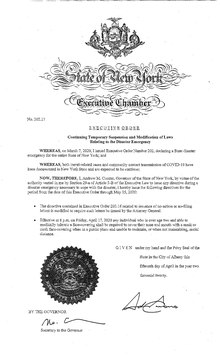State executive order

In the United States, a state executive order is a directive issued by a governor that regulates operations of the state government and certain aspects of citizen life.[1] Powers of state executive orders are limited by the respective state constitution and/or executive and state law, and are also subject to the provisions of the United States Constitution and any applicable federal law.[2]
Similar to presidential executive orders, they are subject to judicial review and can be invalidated if determined to violate any statutes or codes by which they are governed. The majority of them carry the force of law[3] and remain in effect until revoked, suspended, canceled, proven unlawful, or expire by a date or condition set forth within itself. In 38 of the 50 states, there is no requirement for orders to undergo administrative procedure, which controls how they are formed and enacted. Six states mandate legislative review, and another six have these requirements only for executive orders of a certain type, like those having to do with the creation of agencies.[4][5][6][7]
Basis in state constitutions
[edit]Powers of executive order can be either constitutional, statutory, implied, or ‘general authority only' (Wyoming).[8] In most state constitutions, there is no specific provision for the power of governors to issue executive orders. However, in many of those constitutions, there is a provision stating that the “executive power shall be vested in the governor” (New York)[9] or “the supreme executive power of this State, shall be vested in a...Governor...” (Nevada),[10] or similar. These sections supplement and give way for executive and state law that grants the powers of issuance of executive orders to governors.
Powers
[edit]State executive orders are usually enacted less frequently than bills passed by state legislatures. They are especially used in the midst of a public health emergency or disaster.[2] During a state of emergency (which usually can only be declared through executive order), the powers of the governor may be expanded beyond their normal reach.[11] This allows for the release and reallocating of various state funds and resources to assist local governments and communities in dealing with crises, as well as modification of laws to aid in such.
Additionally, in many states, orders can be used for a large range of executive actions, including but not limited to:
- Temporarily suspending or modifying any statute, local law, ordinance, order, rule, regulation, or parts thereof
- Granting clemency[12]
- Commuting or pardoning a criminal sentence[9]
- Declaring a state of emergency
- Creating state agencies
- Redirecting state agencies and departments to help a certain purpose [11]
- Issuing directives necessary to cope with a disaster or emergency
Note that some of these powers can only be invoked after the declaration of a state of emergency.
Reactions and controversy
[edit]In light of the COVID-19 pandemic, virtually all US state governors have issued some type of order either putting in place a stay-at-home mandate or advisory.[13][14] As tensions escalated and Americans grew tired of quarantine, there were many protests in response, especially in Michigan.[15] These protests called for “reopenings” of states, and many have brought into question the constitutionality of long-term quarantines and other large-scale societal changes imposed by governors.[16]
See also
[edit]- List of United States governors
- List of states and territories of the United States
- Decree
- State legal systems
References
[edit]- ^ "Governors' Powers & Authority". National Governors Association. Retrieved 2020-06-10.
- ^ a b Gakh, Maxim; Vernick, Jon S.; Rutkow, Lainie (2013). "Using Gubernatorial Executive Orders to Advance Public Health". Public Health Reports. 128 (2): 127–130. doi:10.1177/003335491312800208. ISSN 0033-3549. PMC 3560871.
- ^ "State and Local Enforcement of Executive Orders on the Rise as Businesses Reopen Across America: Be Prepared to Respond". JD Supra. Retrieved 2020-06-10.
- ^ Washington, 1440 G. Street NW; Skype, DC 20005 202-742-1520 Call with (2014-07-24). "How accessible are executive orders in each of the 50 states?". Sunlight Foundation. Retrieved 2020-06-10.
{{cite web}}: CS1 maint: numeric names: authors list (link) - ^ About Executive Orders of the State of Colorado
- ^ About Executive Orders of the State of Georgia
- ^ About Executive Orders of the State of Washington
- ^ "Gubernatorial Executive Orders: Authorization, Provisions, Procedures" (PDF). National Governors Association. Retrieved June 10, 2020.
- ^ a b "Governor of New York". Ballotpedia. Retrieved 2020-06-10.
- ^ "Governor of Nevada". Ballotpedia. Retrieved 2020-06-10.
- ^ a b "What powers does Pritzker have in an emergency? And what has he ordered so far?". Illinois Policy. 2020-06-09. Retrieved 2020-06-10.
- ^ Florida Senate. "Florida Constitution". Florida Senate. Retrieved June 10, 2020.
- ^ "State Executive Orders – COVID-19 Resources for State Leaders". Retrieved 2020-06-10.
- ^ Gottlieb, Cleary (June 2, 2020). "Response to COVID-19: State Executive Orders" (PDF). Cleary Gottlieb. Retrieved June 10, 2020.
- ^ Egan, Paul; Berg, Kara. "Thousands converge to protest Michigan governor's stay-home order in 'Operation Gridlock'". USA Today. Retrieved 2020-06-10.
- ^ Kahn, Debra (22 April 2020). "Newsom executive orders test constitutional bounds — and legislative goodwill". Politico PRO. Retrieved 2020-06-10.
